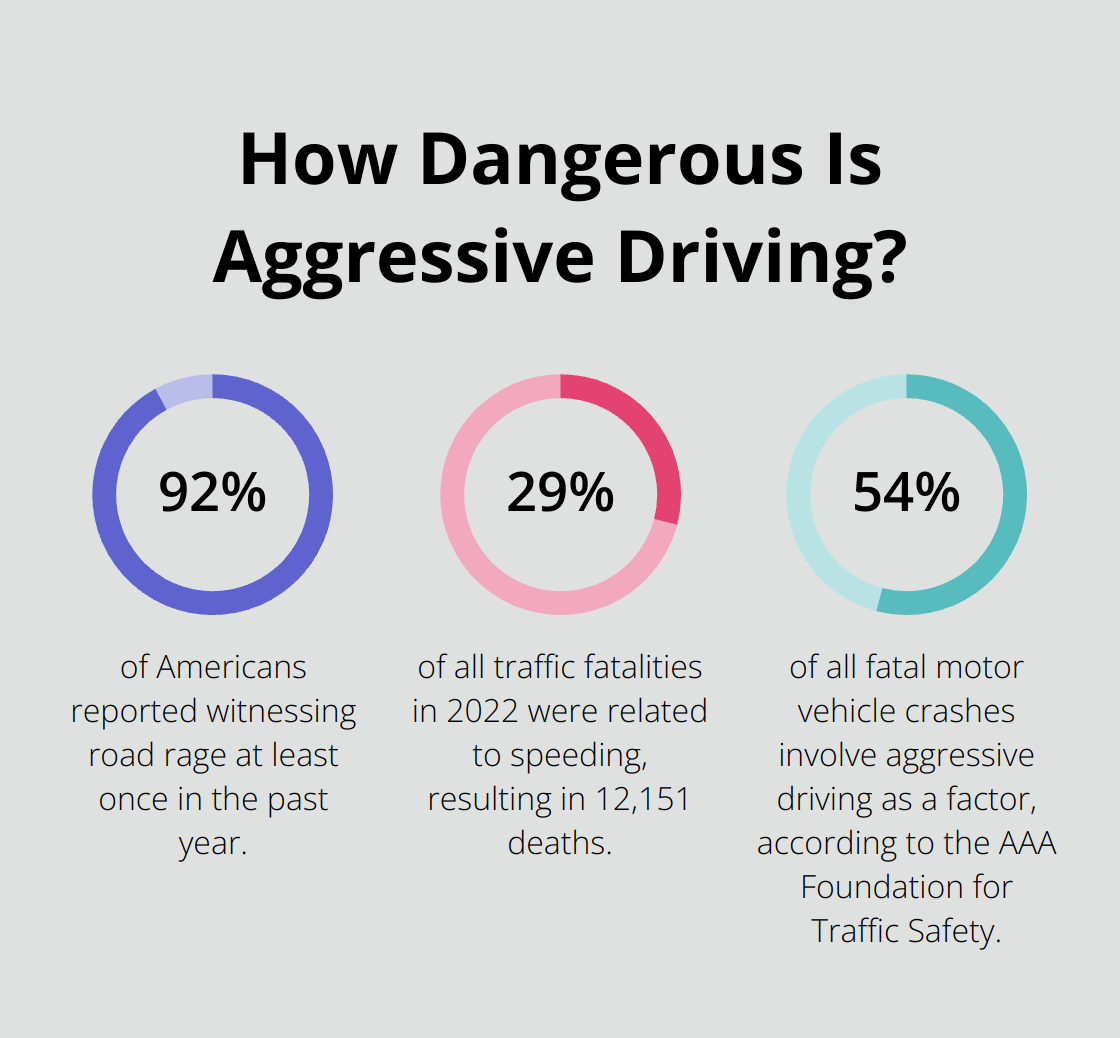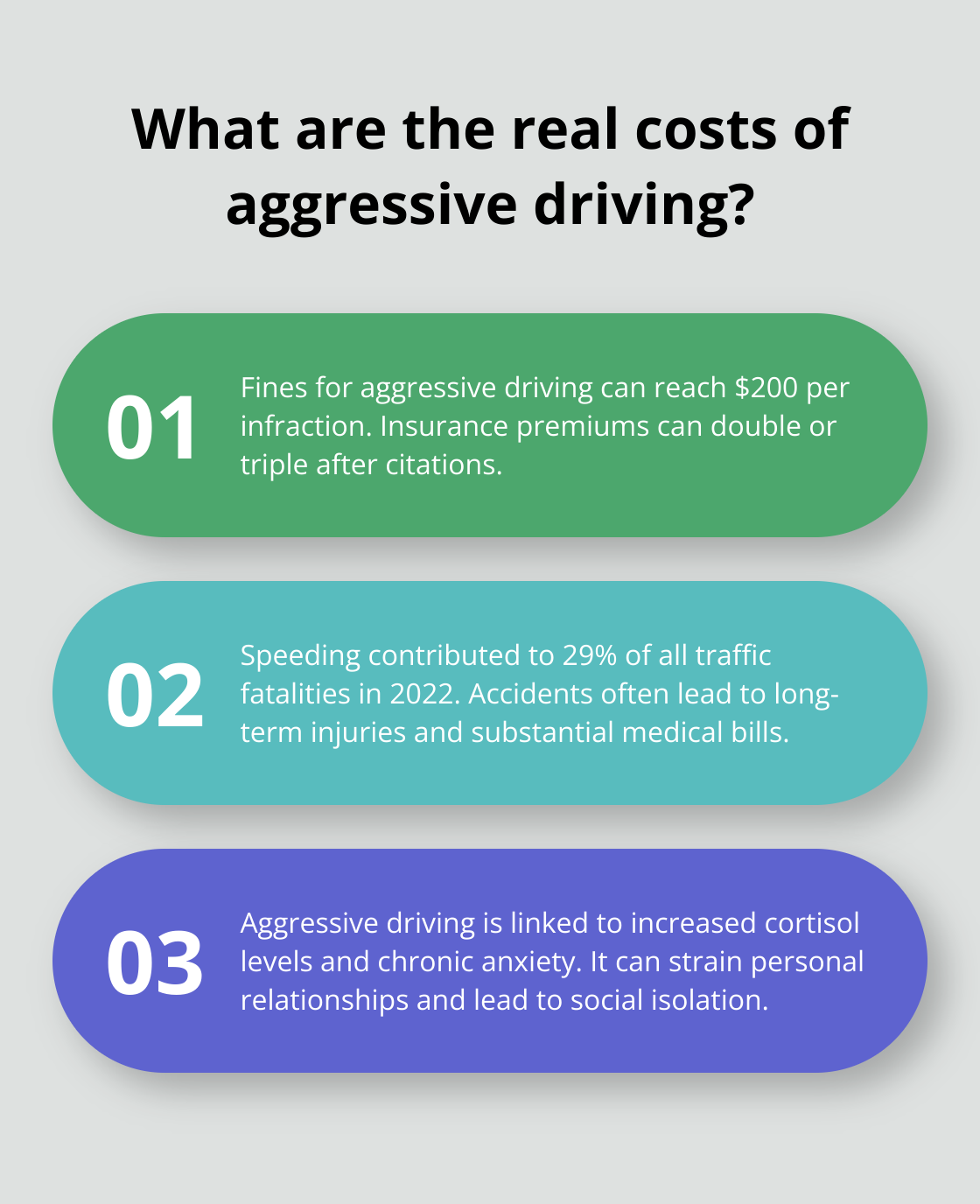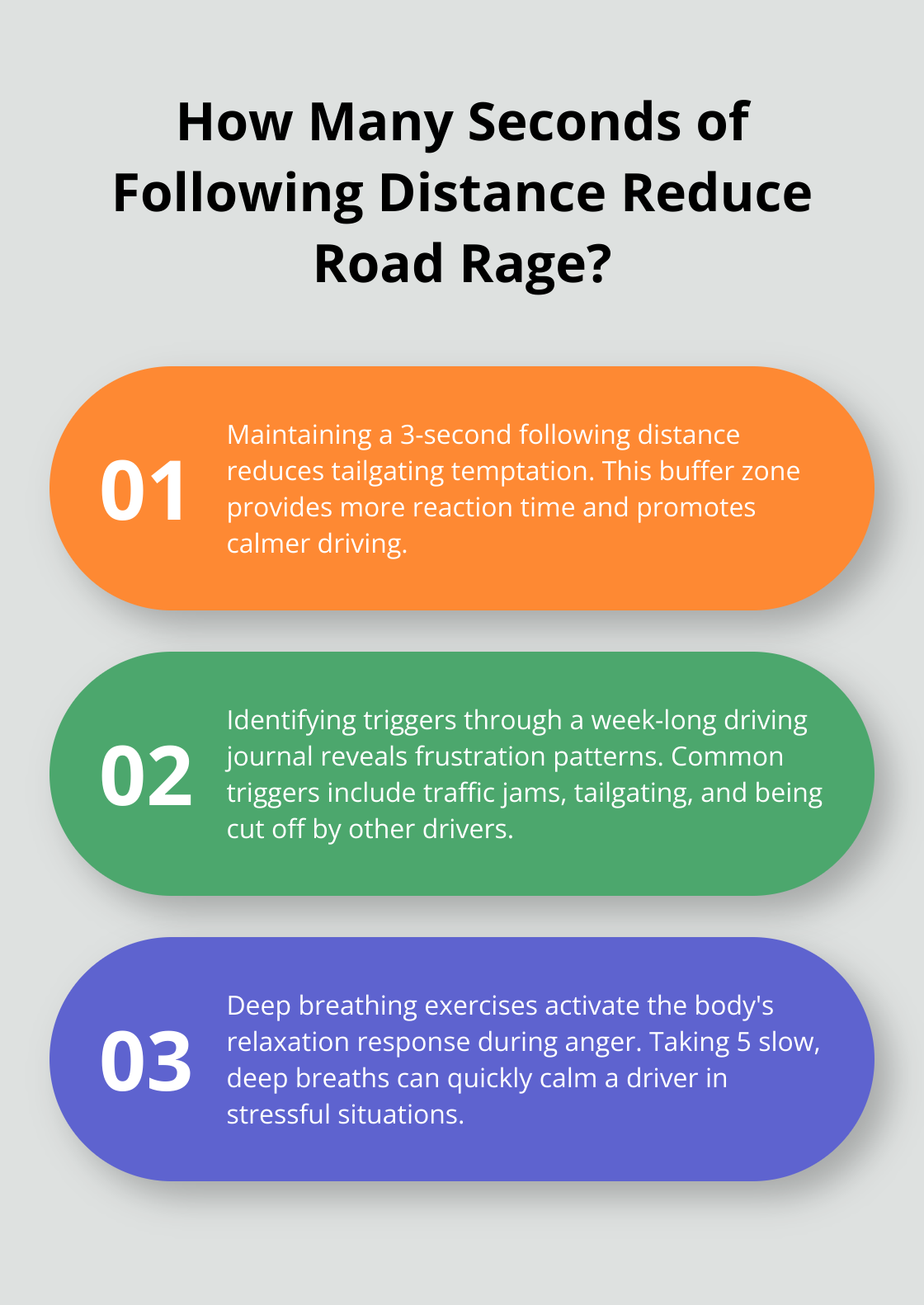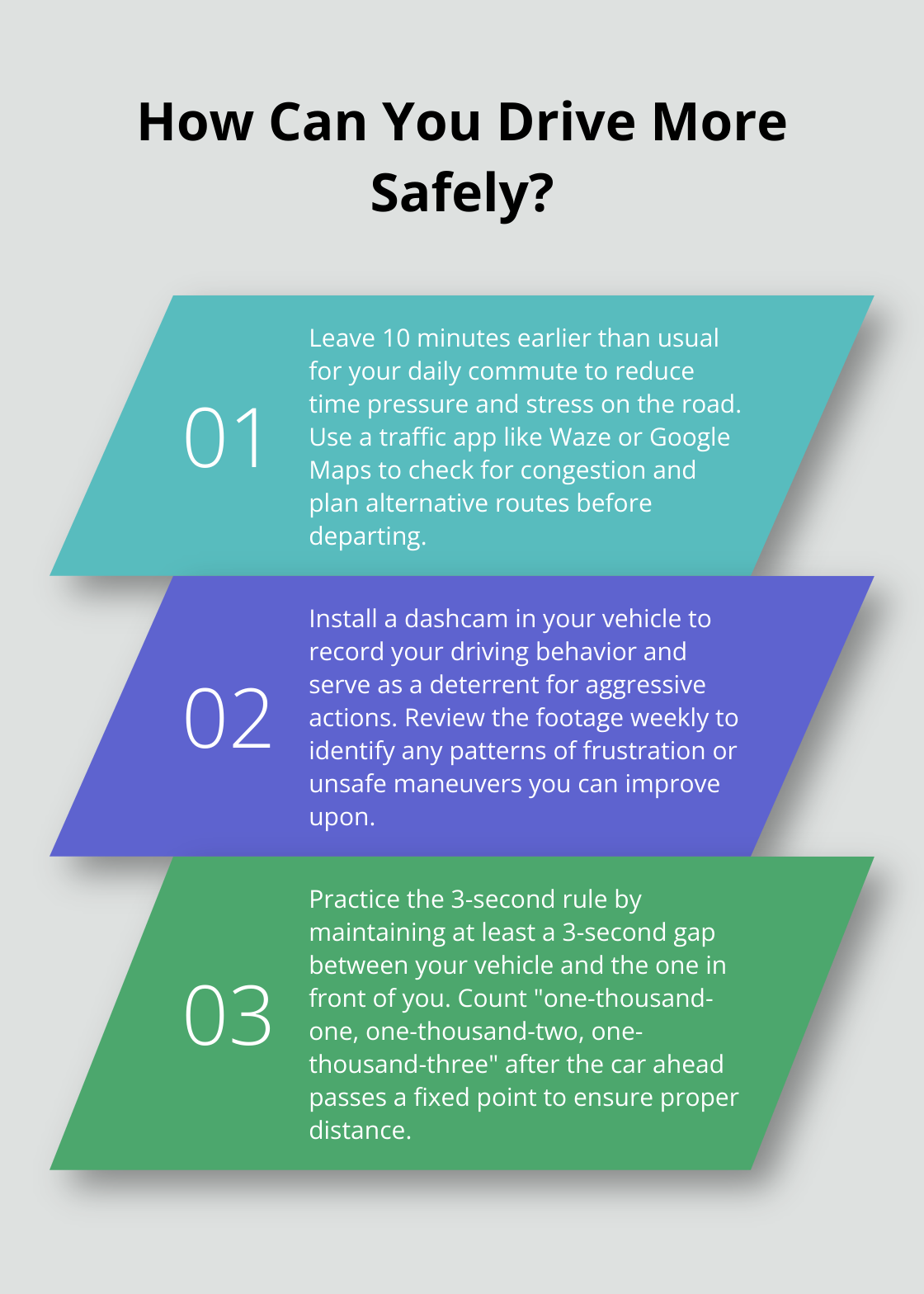At The Wiser Driver Driving School, we’ve seen firsthand the dangers of aggressive driving on our roads.
Aggressive driving habits not only put lives at risk but also lead to legal troubles and strained relationships.
Our aggressive driving course is designed to help drivers recognize and overcome these dangerous behaviors.
In this post, we’ll explore effective strategies to curb aggressive driving and promote safer roads for everyone.
What Is Aggressive Driving?
Definition and Scope
Aggressive driving poses a serious threat to road safety, with approximately 92% of Americans reporting witnessing road rage at least once in the past year. It encompasses any behavior that endangers people or property on the road. This issue extends beyond mere frustration or impatience; it represents a pattern of dangerous actions that can lead to severe consequences.
Common Aggressive Behaviors
The most frequent aggressive driving behaviors include:
- Tailgating
- Excessive speeding
- Weaving through traffic
- Running red lights
- Blocking lane changes
- Excessive horn use

The National Highway Traffic Safety Administration reports that speeding factored into 29% of all traffic fatalities in 2022 (resulting in 12,151 deaths). This statistic underscores the deadly nature of aggressive driving habits.
The Psychology Behind the Wheel
To address aggressive driving, we must understand its root causes. Stress, time pressure, and the anonymity of being in a vehicle all contribute significantly. Aggressive driving is a factor in 54% of all fatal motor vehicle crashes, according to the AAA Foundation for Traffic Safety. This high percentage highlights the prevalence of these dangerous behaviors while driving.
Environmental Factors
Traffic congestion stands out as a major contributor to aggressive driving. As urban areas expand and roads become more crowded, drivers often feel frustrated and resort to aggressive tactics. Weather conditions also play a role; poor visibility or slippery roads can increase stress levels and lead to rash decisions.
The Role of Technology
While technology has improved many aspects of driving, it can also contribute to aggressive behavior. Distracted driving, often caused by mobile phone use, can result in sudden maneuvers that appear aggressive to other drivers. The NHTSA reported 3,522 fatalities resulting from distracted driving in 2021, emphasizing the severity of this issue.
Understanding these behaviors and their triggers marks the first step towards changing habits and creating safer roads. The next section will explore the far-reaching consequences of aggressive driving, from personal safety to legal implications.
The Hidden Costs of Road Rage
Financial Implications of Aggressive Driving
Aggressive driving carries a hefty price tag that extends far beyond the immediate moment on the road. Fines for aggressive driving violations can reach up to $200 per infraction, and this is just the tip of the iceberg. Multiple offenses often lead to license suspension, mandatory attendance at anger management classes, and in severe cases, jail time. Insurance premiums skyrocket after aggressive driving citations, sometimes doubling or tripling annual costs. These financial burdens persist for years, affecting everything from job prospects to housing opportunities.
The Physical Toll of Accidents
Aggressive driving significantly increases the risk of accidents. The National Highway Traffic Safety Administration reports that speeding was a contributing factor in 29% of all traffic fatalities in 2022. These statistics represent real lives lost and families torn apart. Even non-fatal accidents often lead to long-term injuries, disability, and substantial medical bills. The physical consequences of aggressive driving can alter the course of a person’s life in an instant.
Mental Health Consequences
The psychological impact of aggressive driving should not be underestimated. Constant anger and stress behind the wheel can lead to chronic anxiety and depression. The American Psychological Association has linked road rage to increased cortisol levels, which can contribute to various health issues over time. Moreover, the guilt and shame following an aggressive driving incident often result in long-lasting emotional distress, affecting overall well-being and quality of life.
Strain on Personal Relationships
Aggressive driving habits frequently spill over into personal relationships. Family members and friends may become reluctant to ride with an aggressive driver, leading to social isolation. Work relationships can deteriorate if these habits manifest in professional settings, potentially jeopardizing career advancement. The strain on personal connections can create a cycle of stress and frustration that further exacerbates aggressive tendencies on the road.
Legal Ramifications
The legal consequences of aggressive driving extend beyond fines and potential jail time. A record of aggressive driving offenses can impact future employment opportunities, especially in jobs that require a clean driving record. In some cases, repeated offenses can lead to permanent license revocation, severely limiting personal freedom and career options. The long-term legal implications of aggressive driving can cast a shadow over one’s future for years to come.

As we explore these hidden costs, it becomes clear that aggressive driving affects every aspect of life. The next section will provide practical strategies to curb these dangerous habits and promote safer roads for everyone.
How Can You Tame Your Road Rage?
At The Wiser Driver Driving School, we believe that curbing aggressive driving habits starts with self-awareness and practical strategies. Most drivers can significantly improve their behavior on the road with the right approach.
Identify Your Triggers
The first step in managing aggressive driving is to recognize what sets you off. Common triggers include traffic jams, tailgating, or getting cut off. Keep a driving journal for a week and note situations that cause frustration. This simple act of self-reflection can reveal patterns you might not have noticed before.
Master Your Emotions
Once you’ve identified your triggers, develop coping mechanisms. Deep breathing exercises can be incredibly effective. When you feel anger rising, take five slow, deep breaths. This technique activates your body’s relaxation response, helping to calm you down quickly.

Another powerful tool is cognitive restructuring. When stuck in traffic, instead of fuming about the delay, use the time productively. Listen to an audiobook or podcast (this shift in perspective can transform a frustrating situation into a learning opportunity).
Embrace Defensive Driving
Defensive driving is the antidote to aggressive behavior on the road. Try to anticipate potential hazards and react calmly. Maintain a safe following distance of at least three seconds behind the car in front of you. This buffer zone gives you more time to react and reduces the temptation to tailgate.
Use your turn signals consistently, even when you think no one is around. This habit promotes predictability and reduces the likelihood of conflicts with other drivers.
Plan Ahead
Many aggressive driving incidents stem from being in a hurry. Leave earlier than you think you need to for your commute or appointments. This extra time acts as a buffer against unexpected delays and helps you stay calm if you encounter traffic or slow drivers.
Consider using traffic apps to check road conditions before you leave. These tools can help you avoid congested areas and plan alternative routes, reducing stress and the likelihood of aggressive behavior.
Harness Technology for Safety
Modern technology offers numerous tools to promote safer driving. Many newer vehicles come equipped with advanced driver assistance systems (ADAS) that can help prevent aggressive driving behaviors. Features like adaptive cruise control maintain a safe distance from other vehicles, reducing the temptation to tailgate or weave through traffic.
For those with older vehicles, consider installing a dashcam. Knowing that your driving is being recorded can serve as a powerful deterrent to aggressive behavior. Plus, in the event of an incident, you’ll have video evidence to support your case.
Final Thoughts
Aggressive driving affects everyone on the road, with consequences that extend beyond the immediate moment. It impacts our finances, health, well-being, and relationships. The power to improve road safety rests in our hands each time we sit behind the wheel. We can choose how to react to challenges we face while driving.

Changing ingrained habits takes consistent effort and practice. Start small by focusing on one strategy at a time to build safer alternatives gradually. Patience and persistence will transform your driving habits, making you a calmer and more confident driver. Our aggressive driving course at The Wiser Driver Driving School can help you enhance your skills further.
We offer comprehensive programs to boost driving confidence and safety for all ages. Our experienced instructors provide personalized guidance to help overcome aggressive tendencies (and develop a more positive approach to road navigation). Take proactive steps to address aggressive driving and play your part in creating safer, more enjoyable journeys for all road users.



